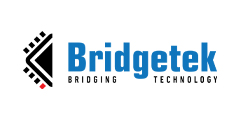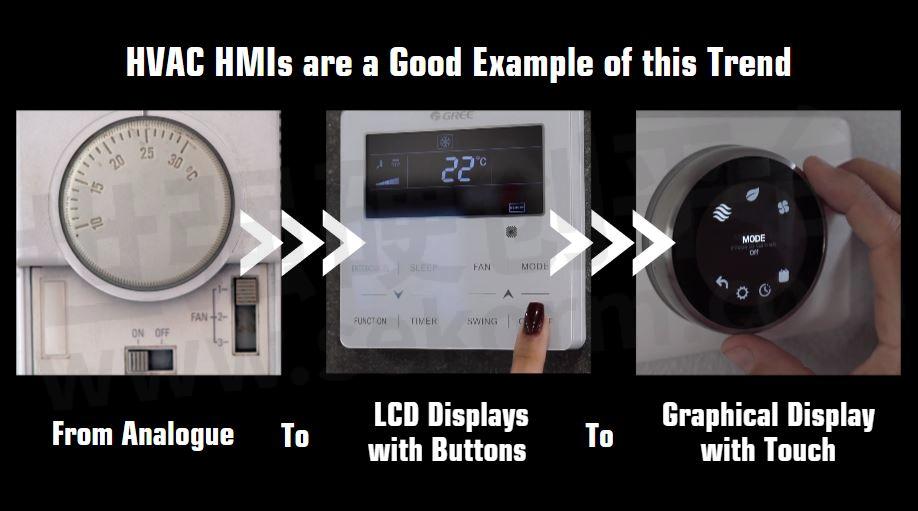Enhance HVAC Controls with an EVE IC for Graphical Touch Display

Embracing the Advent of Colour Touch Displays in HVAC Controls
The advent of colour of touch displays has revolutionized devices and system control, offering significant benefits, particularly from the user’s perspective.

Heating Ventilation Air-Conditioning (HVAC) controls are an excellent example of this trend, with the design evolving from basic dials through Liquid Crystal Display (LCD) screens and fixed-segment LCDs, to full colour touch screens.
The last step to Colour Touch Displays is a very significant and welcoming one.
Traditional user interfaces such as LCD fixed-segment displays have significant limitations, forcing design engineers to make compromises when creating the user interface. With a colour graphical touch display, design engineers now work with a blank canvas, finally giving them the freedom to create amazing interfaces which are designed with a strong focus on the user.

Challenges in Adopting Graphical Displays
Some engineers hesitate to embrace this trend especially when working on updates to legacy products like HVAC controls. Some of their concerns include:
MCU Transition Apprehension:
Engineers believe that they would require to switch to a high-end, and far more complex, Microcontroller Unit (MCU) with graphics capabilities in order to implement graphical touch interface.
Learning Curve Complexity:
The significant differences in onboard peripherals, hardware design rules, firmware frameworks, and development tools of high-end MCUs pose a substantial learning curve for design engineers.
Dependency on Software Tools:
The graphics code’s dependence on specific software tools for a particular MCU family raises concerns about the potential repetition of the process in the event of future MCU changes.
User Interface Implementation Anxiety:
Engineers may feel anxious about implementing user interfaces for graphical screens, given the vast possibilities and ideas they generate, surpassing the simplicity of basic displays.
Tool Importance for Optimal Results:
Having the right tools is crucial for design engineers to deliver optimal results when working with graphical displays, as the complexity of the interface goes beyond what basic displays typically involve.
EVE – Making Things Easy for design Engineers
However, the process is much more straightforward with the right approach. Our Embedded Video Engine (EVE) from Bridgetek is one approach, having it act as a “graphics card” for an existing/preferred MCU, alleviating much of the workload. Programmers will also find EVE-based display programming surprisingly easy compared to dot matrix or segment LCDs, with the following advantages.
Easy to Learn:
Comprehensive free-of-charge tools, code examples, and technical support make EVE programming quick an easy for design engineers.
Easy to Integrate:
EVE seamlessly connects to the MCU over SPI/QSPI, allowing minimal changes in the existing code. EVE display code routines can be effortlessly ported to a different MCU, this is useful as HVAC controllers continue to “evolve” in future. Find out more in our EVE development workflow.
Create Attractive and Intuitive Interfaces:
Designers can craft user interfaces without the constraints imposed by small alphanumeric or fixed-segment displays. EVE supports various languages and offers built-in widgets for common controls.
Integrated Touch and Audio:
EVE’s built-in touch features enhance user-friendliness, and the integrated audio features enable easy acknowledgment of touch and generation of sound alerts with minimal effort from the MCU.
Versatility:
EVE supports a wide range of displays, from 3.5″ or 5″ for existing form-factors to 7″ or 10″ for larger products, and even circular displays for additional styling.
Conclusion
Integrating a colour graphical touch display into control panels, particularly for systems like HVAC, can greatly elevate the overall product experience for users.
Despite this, design engineers may be reluctant to embrace this change, anticipating complex hardware and software changes, steep learning curves, and the challenges associated with crafting a high-quality user interface. In doing so, they can miss out on the opportunity to make their product much more appealing.
Fortunately, you need not fear. This is achieved easily and effectively with Bridgetek’s innovative EVE graphic controller solution; complemented by robust support tools and hardware evaluation boards. Design engineers can now surmount these obstacles, making the process of enhancing their product more accessible and straightforward.
- +1 Like
- Add to Favorites
Recommend
- 3 Main Display Applications in E-mobility
- Leonardo, A Customizable Display Based on Android for Off-highway Applications
- 7.8-inch/10.13-inch Full-color E-paper LCD Displays Is Your Reading Ideal Companion
- Elevate your Lift Controls with EVE in Graphical Touch Display Controls
- Manitou Adopts the MTA Giotto and Leonardo Displays on Several of Its Telescopic Handlers for the Construction Market
- 12“ Onboard Data Display Made by MTA forHolland‘s Tractors
- Black Hawk, The 8“ Display Stands Out for A Series of Sophisticated Technical Features Specific to Off-highway Use
- The MTA Giotto Display for the Innovative Bobcat T7X Compact Track Loader
This document is provided by Sekorm Platform for VIP exclusive service. The copyright is owned by Sekorm. Without authorization, any medias, websites or individual are not allowed to reprint. When authorizing the reprint, the link of www.sekorm.com must be indicated.





























































































































































































































































































































































































































































































































































































































































































































































































































































































